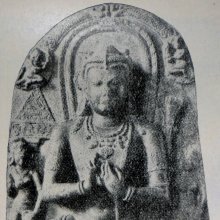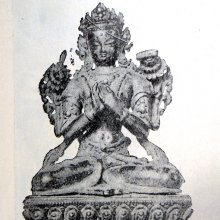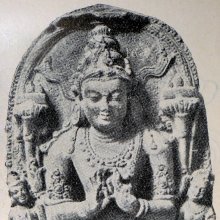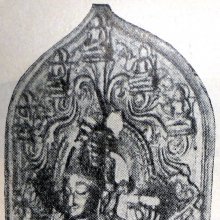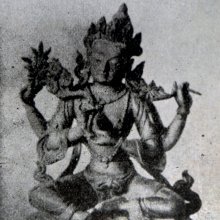Yamantaka, Yamāntaka, Yama-antaka: 13 definitions
Introduction:
Yamantaka means something in Buddhism, Pali, Hinduism, Sanskrit. If you want to know the exact meaning, history, etymology or English translation of this term then check out the descriptions on this page. Add your comment or reference to a book if you want to contribute to this summary article.
Images (photo gallery)
(+3 more images available)
In Hinduism
Purana and Itihasa (epic history)
Source: Cologne Digital Sanskrit Dictionaries: The Purana IndexYamāntaka (यमान्तक).—A commander of Bhaṇḍa.*
- * Brahmāṇḍa-purāṇa IV. 21. 82.

The Purana (पुराण, purāṇas) refers to Sanskrit literature preserving ancient India’s vast cultural history, including historical legends, religious ceremonies, various arts and sciences. The eighteen mahapuranas total over 400,000 shlokas (metrical couplets) and date to at least several centuries BCE.
In Buddhism
Tibetan Buddhism (Vajrayana or tantric Buddhism)
Source: archive.org: The Indian Buddhist Iconography1) Yamāntaka (यमान्तक) or Yamāri is the name of a deity and one of the various emanations of Akṣobhya, as mentioned in the 5th-century Sādhanamālā (a collection of sādhana texts that contain detailed instructions for rituals).—When Yamāntaka is red he is called Raktayamāri and when he is blue he is called Kṛṣṇayamāri. Yamāri or Yamāntaka may either be worshipped alone or in conjunction with his Prajñā. He should have the head of a buffalo on his shoulders and should ride a buffalo.
Getty records a tradition current in Tibet which gives the origin of this fearful god.
“There was once a holy man who lived in a cave in deep meditation for fifty years after which he was to enter Nirvāṇa. On the night of the forty-ninth year, eleventh month and twenty-ninth day two robbers entered the cave with a stolen bull and slaughtered it there. But when they discovered the presence of an ascetic, a witness to their crime, beheaded him and lo ! his body assumed the ferocious form of Yama and taking up the bull’s head he set it up on his headless shoulder. He then killed the two robbers and drank their blood from the cup made out of their skulls. In his fiery and insatiable thirst for victims he threatened to depopulate the whole of Tibet. The Tibetans appealed to their Tutelary deity, Mañjuśrī, who thereupon, assumed the fierce form of Yamāntaka and defeated Yama in a fearful struggle”.
2) Yamāntaka (यमान्तक) presides over the east and represents one of the ten deities of the quarters (Dikpāla) commonly depicted in Buddhist Iconography, and mentioned in the 11th-century Niṣpannayogāvalī of Mahāpaṇḍita Abhayākara.—His Colour is blue; he has six arms and three faces.—Yamāntaka presides over the East and is one of the popular deities of the Buddhist pantheon He is also known as Yamāri who is often endowed with two forms known as Kṛṣṇa-Yamāri and Rakta-Yamāri.
Yamāntaka is described in the Niṣpannayogāvalī (mañjuvajra-maṇḍala) as follows:—
Source: The Art of Asia: Tibetan Buddhism“On the Eastern spoke of the wheel there is Yamāntaka of blue colour. His three faces have blue, white and red colour. He holds in his four hands the hammer marked with the blue vajra, the sword, the jewel and the lotus”.
[In the vajrahūṃkāra-maṇḍala his second name is given as Vajradaṇḍa.]
Yamantaka (a Vidyarajas) (Chinese: Ta wei te; Japanese: Daiitoku), Conqueror of Death, is believed to be a manifestation of the ultimate wisdom which overcomes evil, suffering and death. In Vajrayana Buddhism, he is frequently depicted as a buffalo headed demon, but in the museums sand mandala, he is symbolized by a blue vajra, or thunderbolt.
Source: academia.edu: The Structure and Meanings of the Heruka MaṇḍalaYamāntaka (यमान्तक) is the name of a Vīra (hero) who, together with the Ḍākinī named Yamāntakī forms one of the 36 pairs situated in the Hṛdayacakra, according to the 10th century Ḍākārṇava chapter 15. Accordingly, the hṛdayacakra refers to one of the four divisions of the sahaja-puṭa (‘innate layer’), situated within the padma (lotus) in the middle of the Herukamaṇḍala. The 36 pairs of Ḍākinīs and Vīras [viz., Yamāntaka] are reddish yellow in color; they each have one face and four arms; they hold a skull bowl, a skull staff, a small drum, and a knife.

Tibetan Buddhism includes schools such as Nyingma, Kadampa, Kagyu and Gelug. Their primary canon of literature is divided in two broad categories: The Kangyur, which consists of Buddha’s words, and the Tengyur, which includes commentaries from various sources. Esotericism and tantra techniques (vajrayāna) are collected indepently.
General definition (in Buddhism)
Source: Wisdom Library: Dharma-samgrahaYamāntaka (यमान्तक) refers to the first of the “ten wrathful ones” (daśakrodha) as defined in the Dharma-saṃgraha (section 11). The Dharma-samgraha (Dharmasangraha) is an extensive glossary of Buddhist technical terms in Sanskrit (e.g., daśa-krodha and Yamāntaka). The work is attributed to Nagarguna who lived around the 2nd century A.D.
Source: Institute of Buddhist Studies: Buddhist Forum, Volume 4 (buddhism)Yamāntaka (यमान्तक).—The presentation of offerings befitting a great protective divinity does not in itself ‘activate’ Yama to perform any specific tasks assigned by a devotee. Yama can be generally propitiated by these offerings—but he may be commanded to perform desired tasks by the superior deity, Yamāntaka (‘Ender of Yama’), in one of his several forms (in a Gsar ma context, Kṛṣṇayamāri, Raktayamāri and Vajrabhairava) since it is Yamāntaka who binds Yama by oath to protect Buddhism.
Languages of India and abroad
Sanskrit dictionary
Source: DDSA: The practical Sanskrit-English dictionaryYamāntaka (यमान्तक).—an epithet of
1) Śiva.
2) of Yama.
Derivable forms: yamāntakaḥ (यमान्तकः).
Yamāntaka is a Sanskrit compound consisting of the terms yama and antaka (अन्तक).
Source: Cologne Digital Sanskrit Dictionaries: Edgerton Buddhist Hybrid Sanskrit DictionaryYamāntaka (यमान्तक).—(= prec.), the usual form in Sanskrit (as a Hindu figure) and in [Buddhist Hybrid Sanskrit], e.g. (Ārya-)Ya° Mahāvyutpatti 4333; usually as one of the (mahā-)krodha, regularly the first in a list of them, as in Dharmasaṃgraha 11; frequent in Sādhanamālā, e.g. 107.11. See next.
Source: Cologne Digital Sanskrit Dictionaries: Shabda-Sagara Sanskrit-English DictionaryYamāntaka (यमान्तक).—m.
(-kaḥ) A name of Siva. E. yama Yama, and antaka destroyer.
Source: Cologne Digital Sanskrit Dictionaries: Monier-Williams Sanskrit-English Dictionary1) Yamāntaka (यमान्तक):—[from yama > yam] m. Y° (regarded) as the destroyer or god of death, [Mahābhārata; Rāmāyaṇa; Buddhist literature] (cf. kālāntaka)
2) [v.s. ...] ‘Y°’s destroyer’, Name of Śiva, [cf. Lexicographers, esp. such as amarasiṃha, halāyudha, hemacandra, etc.]
3) [v.s. ...] [dual number] Y° and the god of d°, [Mārkaṇḍeya-purāṇa]
Source: Cologne Digital Sanskrit Dictionaries: Yates Sanskrit-English DictionaryYamāntaka (यमान्तक):—[yamā+ntaka] (kaḥ) 1. m. A name of Shiva.
[Sanskrit to German]
Sanskrit, also spelled संस्कृतम् (saṃskṛtam), is an ancient language of India commonly seen as the grandmother of the Indo-European language family (even English!). Closely allied with Prakrit and Pali, Sanskrit is more exhaustive in both grammar and terms and has the most extensive collection of literature in the world, greatly surpassing its sister-languages Greek and Latin.
See also (Relevant definitions)
Partial matches: Yama, Antaka.
Ends with: Syamantaka, Vedantasyamantaka.
Full-text (+144): Santaka, Krodha, Yamantika, Kalantayama, Mahakrodha, Mahakrodharajan, Antaka, Locanaka, Kalantakayama, Vajradanda, Yamari, Dashakrodha, Raktayamari, Vajrabhairava, Ten Wrathful Ones, Cala, Roga, Kubera, Vidya, Mahavidya.
Relevant text
Search found 11 books and stories containing Yamantaka, Yamāntaka, Yama-antaka; (plurals include: Yamantakas, Yamāntakas, antakas). You can also click to the full overview containing English textual excerpts. Below are direct links for the most relevant articles:
Blue Annals (deb-ther sngon-po) (by George N. Roerich)
Chapter 4 - Yamāntaka Cycle < [Book 7 - The preaching of the Tantras]
Chapter 2b - Kyungpo Naljor disciples (ii): siddha skyer sgangpa dharma seng ge < [Book 9 - Kodrakpa and Niguma]
Chapter 1 - The first lineage (brgyud pa dang po’i skabs) < [Book 12 - Peace-Making Lineages]
The gods of northern Buddhism (by Alice Getty)
The Indian Buddhist Iconography (by Benoytosh Bhattachacharyya)
Figure 83-86 - Mañjuśrī Mañjuvara
Figure 237 - Eight Dikpālas: Agni
The Shiva Purana (by J. L. Shastri)
Chapter 24 - Nature of women (strī) < [Section 5 - Umā-Saṃhitā]
The Great Chariot (by Longchenpa)
Part 6 - The divisions of the three inner tantras < [A. Resolving the view]
Part 4a.3 - Meditating on the deities < [B. The explanation of meditation practice, together with its action of ripening and freeing]
Part 4a.1 - Meditation on the protection circles < [B. The explanation of meditation practice, together with its action of ripening and freeing]
The Way of the White Clouds (by Anāgarika Lāma Govinda)
Chapter 47 - Critical Days < [Part 4 - Return to Western Tibet]
Chapter 50 - The Discovery of the Secret Path and the Temple of the Great Maṇḍala < [Part 4 - Return to Western Tibet]
